Key points
During World War Two, there were significant changes to life in Britain.
German U-boatA German submarine used to sink British ships during the Battle of the Atlantic. were sinking ships in the Atlantic, causing food shortages.
Children were evacuated to the countryside to keep them safe from the bombing of towns and cities.
As in World War One, women took up the jobs that men were no longer able to do, as they had been sent to the front to fight.
Video about how World War Two changed Britain
Narrator:
World War Two had a major impact on British people at home. They suffered many hardships during the war, such as bombings, evacuations, rationing and the loss of loved ones. Conscription, when men were required to join the armed forces during the war meant that a new workforce of people primarily made up of women and older people was mobilised to keep the country running during the war years. The war effort in Britain was known as the ≥…»ÀøÏ ÷ Front. People felt they were all working towards a common purpose.
During the war education for children had been identified as something that must improve. The government implemented the Education Act of 1944, which created a school system that provided free education to all secondary school children in Britain.
The sense of unity that had been forged during the war years meant that after the war, the government wanted to support people and help repay them for all their hard work. They began to set up the welfare state.
The National Insurance Act of 1946 required all working people to pay a small percentage of their salaries to the government as a tax, who would then provide a welfare system that included financial assistance to people if they lost their jobs and when they retired.
Almost four million homes were destroyed during the war. In order to solve this problem and to provide other houses that were needed, the Government implemented acts of parliament that meant many new homes would be built.
The Emergency Hospital Service provided free care and treatment to those injured in the war. This led to increased calls for a public health service to be created and ultimately contributed to the formation of the National Health Service in 1948, which provided free health care to all.
World War Two caused many challenges for the people of the UK, but it also led to many political, economic and social changes that are still an important part of British society today.
British society and the impact of war
When war broke out in September 1939, the British people knew it would be different from World War One. They had seen newsreels of the damage the German LuftwaffeThe German air force. had caused in Spain. The city of Guernica had been heavily bombed, and people were shocked to see the devastation that these bombing raids had caused.
The British government launched a campaign to show people what they needed to do to be safe, and to maintain public support for the war effort.
Evacuation
The government had prepared for evacuation before war broke out. This meant that as soon as Poland was invaded, on 1 September 1939, the UK government was ready to move children and other vulnerable people out of towns and cities and into the countryside.
The initial campaign was highly successful. 1.5 million children, 7,000 disabled people and 13,000 pregnant women were evacuated in just three days. 103,000 teachers were also evacuated. They went to help the children continue with their education.
During the Phoney WarThe first eight months of World War Two, during which there was almost no actual military conflict in Europe. there was no bombing of British towns, and many children struggled to settle in the countryside. As a result, by the start of 1940, it was estimated that half of the evacuees had returned home. The government launched a campaign to persuade parents to leave their children in the countryside.
Evacuation was a difficult experience for some children. They struggled to cope with life in the countryside, away from their families, while some host families were shocked by the levels of poverty that the children had been living in.
What is the message of this World War Two poster?

The poster above was produced during World War Two by Britain’s Ministry of Health, which was in charge of evacuating children from cities.
The man bending down to speak to the little boy is an Air Raid Precaution warden, whose job was to help people get to a shelter in the event of an air raid.
Look at the source carefully. What do you think the message of this poster could be?
You could infer from this poster that the government wanted to send a message to the public about the importance of evacuating children to the countryside. You could also infer that the government was worried about parents bringing their children home to cities too early, as this could put them in danger.
You could make these inferences from looking at the following details:
- The young boy, who has been brought home from the countryside too early, or perhaps never evacuated at all.
- The Air Raid Protection warden talking to the boy. Air Raid Protection wardens were responsible for helping people to safety during an air raid.
- The British Union flag flying behind the boy on top of some ruined buildings. This could represent pride in the British war effort, despite all of the damage from the bombs.
- The text of the poster, showing that the Air Raid Warden has the situation under control.
- The name of the government organisation arranging the evacuation scheme at the bottom of the poster, the Ministry of Health.
Food and clothing
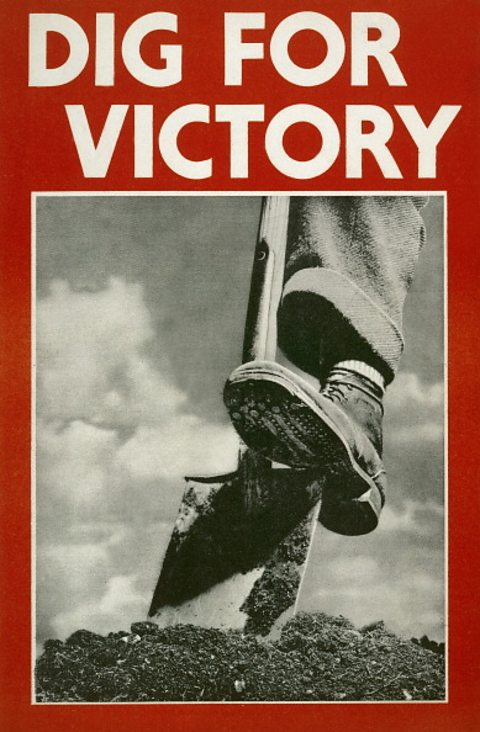
The Battle of the Atlantic involved German U-boats trying to sink cargo ships bringing supplies to Britain. This had the potential to cause food shortages in Britain. To ensure people did not starve, rationingThe system of limiting people's access to things that were difficult to get during World War Two. People were allowed limited amounts of food, clothing and soap during the war. This meant that there would be enough goods for everyone. was introduced to make sure people got enough food to live on. Without rationing, food prices would have risen dramatically and there was a danger that poorer people would not be able to afford to eat. Rationing ensured everyone would have access to food. Books of ration vouchers were given out, and these could be exchanged for food. Items such as meat, cheese and sugar were all rationed.
In a further effort to deal with food shortages, the British government launched a campaign to persuade people to grow their own food. This was called ‘Dig for Victory’. To support this, land was used in parks, golf courses and people’s lawns to create more space for growing crops.
The rationing and Dig for Victory efforts were highly successful. There were no recorded cases of British people starving to death because of food shortages in World War Two. This was not the case across the British Empire. India was under the direct rule of Britain, and up to 3 million people died in a famine in Bengal, India, in 1943.
Supply shortages also affected clothing. Rationing of clothes was introduced in June 1941. The following year, the Utility Clothing Scheme was introduced. This was an initiative by the government to regulate and control the quality and materials used to make clothes. This helped to significantly reduce the amount of cloth needed to make new garments. Clothes made under the scheme were labelled ‘CC41’, standing for Civilian Clothing 1941.

Civil defence
Following the Battle of Britain, German tactics changed. Instead of trying to defeat the RAFThe Royal Air Force - the collective name for Britain's fighter and bomber planes., they started using the LuftwaffeThe German air force. to bomb British towns and cities. To try and protect people, air raid sirens were set up to warn people when to seek shelter. Anderson shelterAn air raid shelter people constructed in their back gardens using corrugated iron. were built in back gardens or yards so people had somewhere to take cover. In London, underground stations were used as shelters.
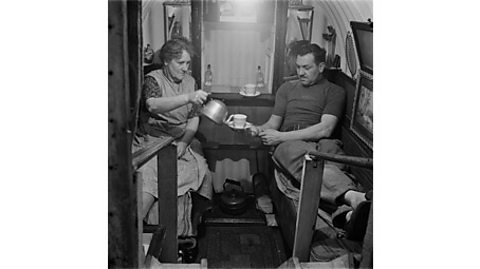
Air Raid Precaution (ARP) wardens were recruited. Their job was to support people in getting to an air raid shelter when a siren sounded. They also ensured people were using blackouts to prevent any light from being visible to German planes overhead. This made it harder for them to work out where cities were.
Men who were too young or old to join the regular Army were recruited into the ≥…»ÀøÏ ÷ Guard. Men who had failed their Army medical screenings also joined. This group was established in May 1940, and by July 1.7 million men had volunteered to join. The ≥…»ÀøÏ ÷ Guard was intended to be the last line of defence against a German invasion. They also provided support for authorities after an air raidAn attack in which bombs are dropped from planes onto the ground below. by sealing off dangerous areas. Given the age of many members of the ≥…»ÀøÏ ÷ Guard, they were given the nickname ‚ÄòDad‚Äôs Army‚Äô. Many of the members of the ≥…»ÀøÏ ÷ Guard had served for the British Army in World War One, so were able to give valuable advice and support to 17 and 18-year-old members ahead of them joining the regular Army.
The role of women
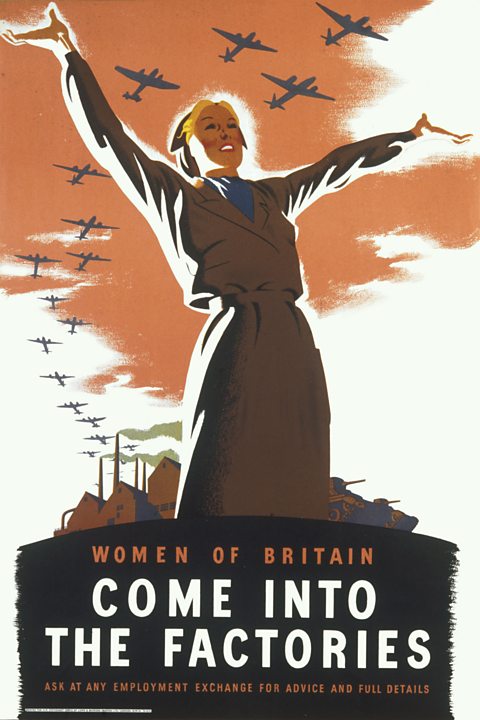
As in World War One, women were required to take up work in factories and businesses to fill the place of men who had joined the armed forces.
In December 1941, a law was passed that conscriptionMaking it compulsory for a particular group of people to join the armed forces. all unmarried women between the ages of 20 and 30 into one of the support services for the armed forces. The Women’s Auxiliary Air Force (WAAF) was set up to provide support for the RAF. It provided administrative support so that men could concentrate on fighting on the front line. Women in the WAAF did jobs such as producing special reports and fixing and loading fighter and bomber planes.
The Auxiliary Territorial Service (ATS) provided support for the Army. They carried out tasks such as delivering, cooking and administration, as well as operating anti-aircraft search lights. They were sometimes sent abroad to support the Army.
The Women’s Transport Service had been set up in the First World War. They were used to support spying operations and to help crack codes of German messages that had been intercepted.
To help with food shortages, the Women’s Land Army was also set up. They worked on farmland to help ensure shortages were not too extreme. They were nicknamed ‘land girls’. By 1944, there were 80,000 women working on the land.

Post-war changes
In 1942, the Beveridge Report outlined five ‘giant evils’ that caused big problems in society. William Beveridge, the writer of the report, identified these as:
disease (caused by a lack of healthcare services)
idleness (caused by a lack of jobs, or the ability to enter employment)
ignorance (caused by poor education, or the inability to access education)
squalor (caused by poor quality housing)
want (caused by poverty)
During World War Two, people had become more used to the government having a greater role in their lives. The Beveridge Report resulted in an expansion of the government’s involvement in providing healthcare, education and pensions to people across the country, known as the welfare stateA system in which the government provides services that are designed to protect their citizens’ health, and give them support during times of need. These services might include a pension scheme, benefits and a health service, such as the NHS.. These changes began under the Conservative government led by Winston Churchill. For example, the Education Act was voted into law in 1944 and made a secondary education free and compulsory for all children.
When a Labour government came into power following the general election of 1945, the new Prime Minister, Clement Attlee, continued to expand the welfare state. These changes included:
Family Allowances Act: Passed into law in 1945, this introduced child benefit to try and reduce rates of child poverty.
The National Health Service: This was created in 1948 to provide free health care for everyone, regardless of income.
Test your knowledge
Play the History Detectives game! gamePlay the History Detectives game!
Analyse and evaluate evidence to uncover some of history’s burning questions in this game.

More on World War Two and the Holocaust
Find out more by working through a topic
- count5 of 10
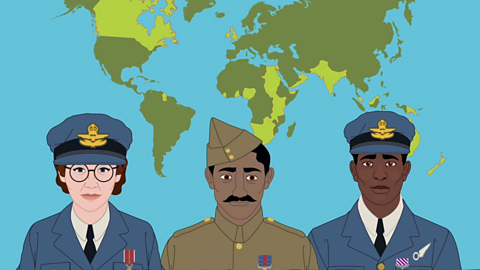
- count6 of 10
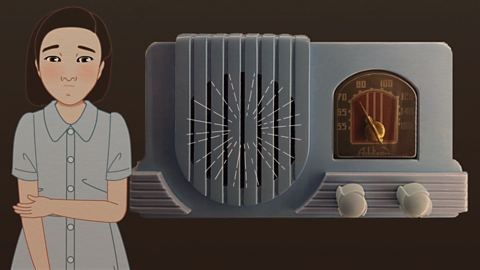
- count7 of 10
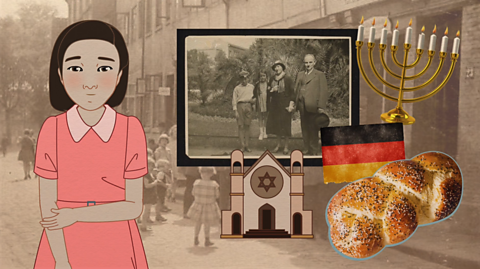
- count8 of 10
